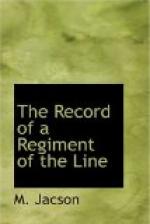The Regiment formed the infantry advance guard of the army, and on reaching what was then named Redvers’ Kopje and afterwards known as Devon Kopje, came under shell fire from three big guns which the Boers had brought into action on the hills above. At this place the Regiment stopped for the day, taking cover from shell fire behind the large boulders of rocks of which the kopje was composed. The remainder of Sir Redvers Buller’s force returned to its old encampment of the previous night.
The two mounted brigades and one battery R.H.A., which had advanced to the foot of the hills occupied by the Boers, returned to camp at dusk.
As soon as it was dark, four companies of the Regiment were left on Devon Kopje as an advanced post, whilst the remainder of the Regiment retired to the rear of the hill and bivouacked. The kopje was entrenched and everything made comfortable for the following day. All the baggage wagons were sent back to the main camp during the night.
September 3rd, 4th, and 5th were spent quietly in position, the Boers on the 5th firing over the heads of the Regiment into the brigade camp, but doing very little damage. On the evening of the 5th a hill to the east was shelled, and after some opposition from the Boers, when Strathcona’s Horse had some casualties, the hill was occupied by the 60th Rifles and the Leicester Regiment. A battery of artillery was then hauled up the steep incline to the top.
On the 6th, General Ian Hamilton having brought up reinforcements consisting of a brigade, from Belfast by way of Dullstrom, thus turning the Boers’ right, General Buller advanced the following day and found that the Boers had evacuated their position. But, in ignorance of this retirement, great preparations were made for a big fight.
The Devonshire Regiment headed the advance of the infantry. It was divided into two half battalions, one half battalion under Major Davies proceeding up the road in support of the mounted troops, whilst five companies under Captain Jacson were sent more to the left to attack the large farm at the foot of the hill, with orders “to proceed as far as possible without severe loss.” These manoeuvres having been accomplished in safety without a shot being fired, the force reached the top and bivouacked some two miles further on for the night. Owing to the steepness of the road the baggage did not arrive till after midnight.
Lydenburg was occupied next day without opposition, the Boers having retired to a position on Paardeplaats, a range of high and irregular hills five miles distant from and overlooking Lydenburg on the Mauchberg-Spitzkop road. From this position the Boers shelled the baggage, bursting shrapnel over it as it defiled into the open in front of the town. The train formed up and halted under cover behind a hill, and came into camp at dusk.
The following morning, September 8th, Sir Redvers Buller decided to attack the Boer position on Paardeplaats, and for this purpose he detailed General Walter Kitchener’s brigade to advance up the spurs of the hills against the Boers’ right, whilst General Ian Hamilton’s brigade was to turn the Boers’ left, the attack being covered by the artillery which proceeded up the main road in the centre.




